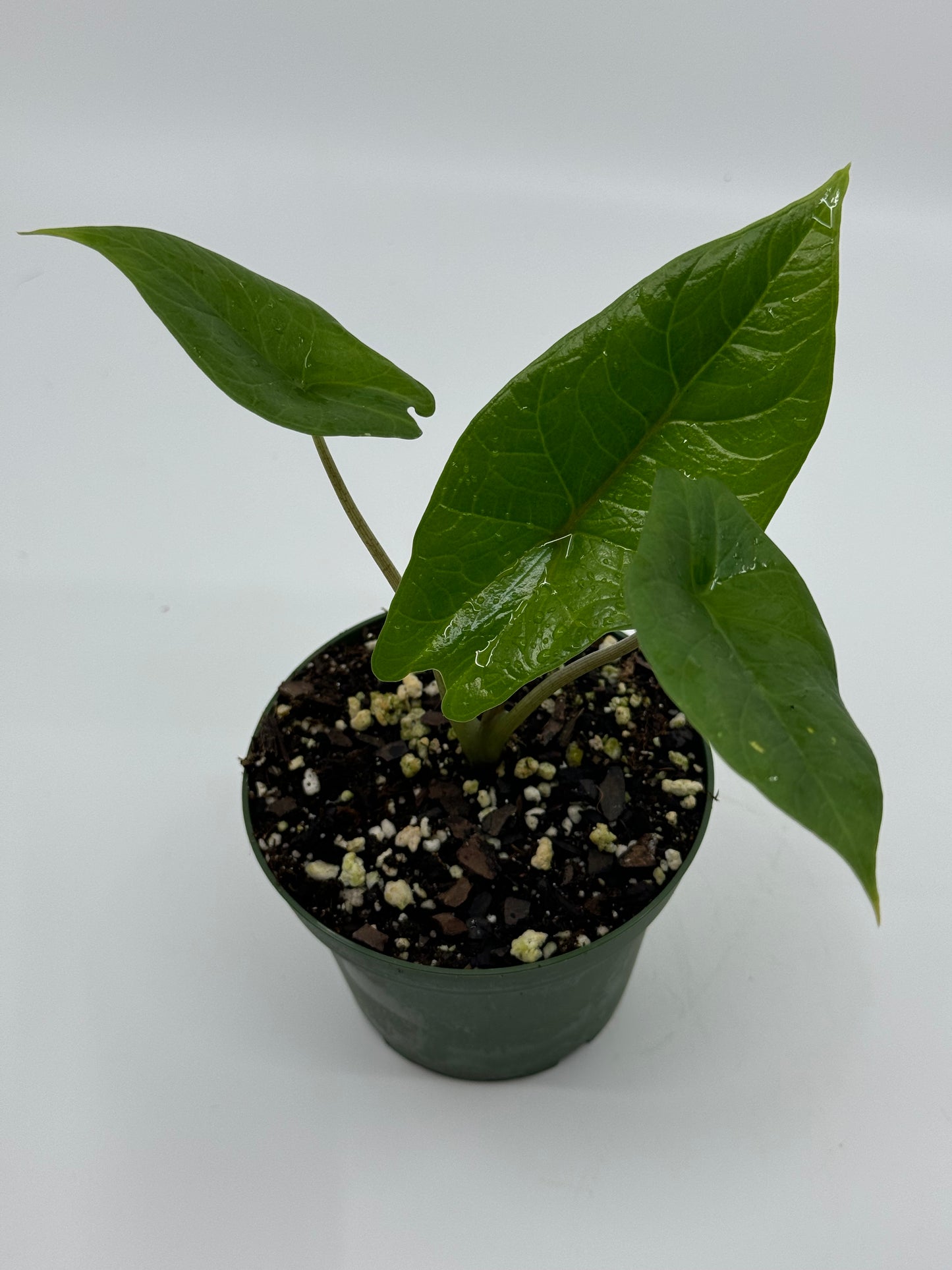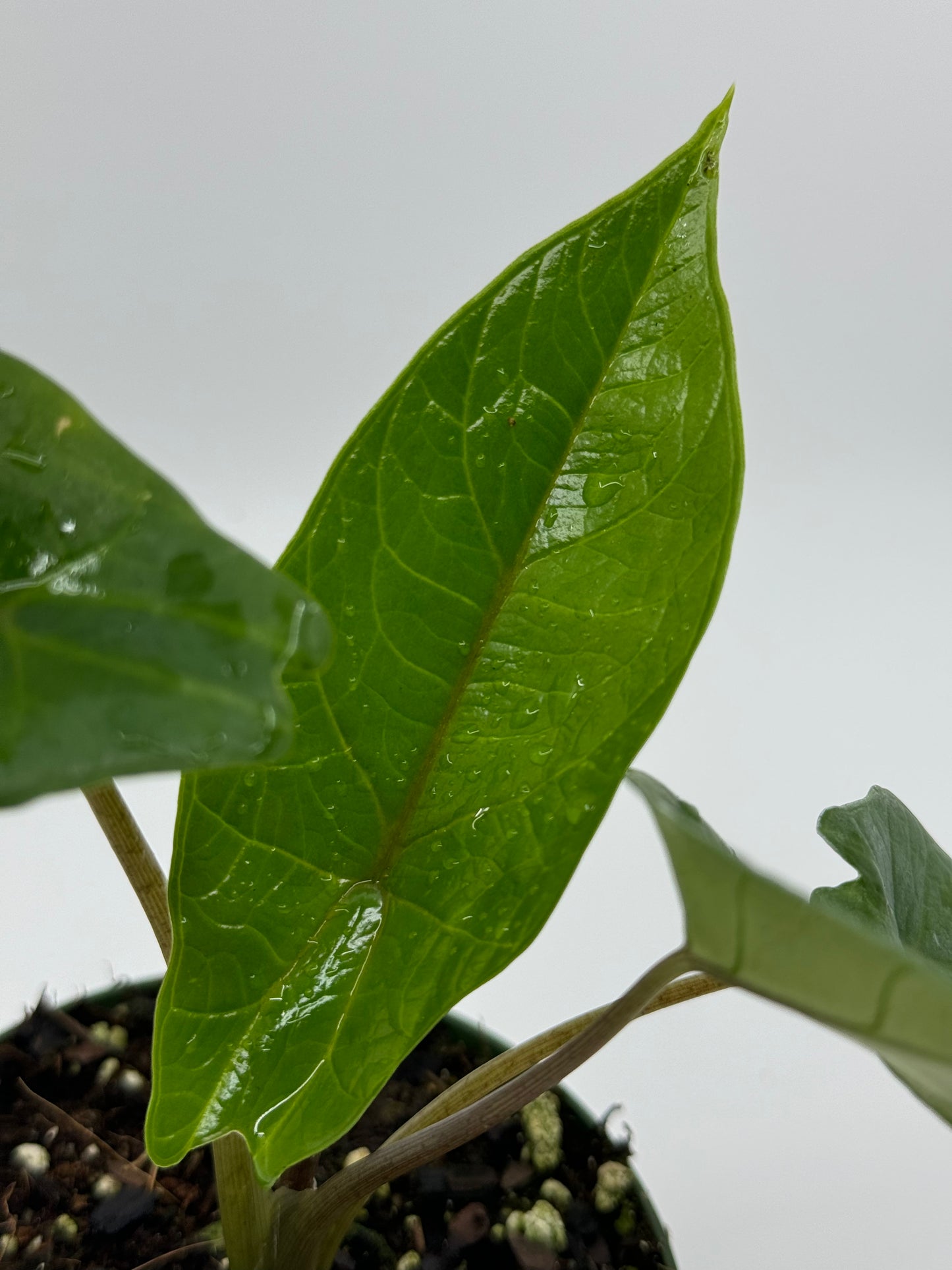Alocasia scalprum
Alocasia scalprum
3 in stock
Couldn't load pickup availability
Alocasia scalprum, commonly referred to as Narrow Sword Alocasia or Scalpel Alocasia, is an exceptionally rare and sought-after species within the Alocasia genus. Native to the Philippines, particularly the island of Luzon, this plant is highly prized by collectors for its distinctive, elongated foliage and unique texture, making it a standout in any plant collection.
Morphological Characteristics:
-
Leaves: The leaves of Alocasia scalprum are its most striking feature. They are narrow, elongated, and lanceolate, typically measuring 20-50 cm in length and 7-12 cm in width. The foliage is a deep, dark green with a matte finish, which contrasts beautifully with the prominent, slightly raised veins that run parallel along the leaf. The texture of the leaves is leathery, with a somewhat corrugated surface that adds to the plant's sculptural appeal. The leaves have a slightly wavy edge and a pointed tip, resembling the shape of a scalpel, which gives the plant its common name.
-
Stems: The stems of Alocasia scalprum are relatively short and thick, typically green with a slight hint of purple or brown, depending on the growing conditions. The petioles are strong and elongated, supporting the narrow, blade-like leaves and contributing to the plant’s upright growth habit.
-
Growth Habit: Alocasia scalprum has a compact, clumping growth habit, with leaves emerging directly from a central rhizome. The plant typically reaches a height of 30-60 cm, making it an ideal choice for smaller indoor spaces or as part of a mixed tropical plant arrangement. Its slow to moderate growth rate and manageable size make it a favorite among collectors who appreciate its unique foliage and low-maintenance nature.
Ecological Preferences:
-
Light: Alocasia scalprum thrives in bright, indirect light but can also tolerate lower light conditions. However, to maintain the intensity of its dark green leaves and overall health, it’s best to provide the plant with ample indirect sunlight. Direct sunlight should be avoided, as it can cause leaf burn and damage the delicate foliage.
-
Soil: This plant prefers a well-draining, rich soil mix that retains moisture without becoming waterlogged. A mix of peat, perlite, and orchid bark is ideal, providing both the moisture retention and aeration needed for healthy root development. The soil should be kept consistently moist, but care must be taken to avoid overwatering, as Alocasia species are prone to root rot.
-
Water: Alocasia scalprum enjoys regular watering, especially during the growing season (spring and summer). Water the plant when the top 2-3 cm of soil feels dry, ensuring that the soil remains evenly moist. During the dormant period (fall and winter), reduce watering frequency, allowing the soil to dry out slightly between waterings.
-
Humidity: This cultivar thrives in high humidity levels, ideally between 60-80%. High humidity helps prevent the leaf edges from browning and supports the plant’s lush, tropical appearance. Using a humidifier or placing the plant on a pebble tray with water can help maintain optimal humidity indoors. In particularly dry environments, misting the plant regularly can also be beneficial.
-
Temperature: Alocasia scalprum prefers warm temperatures, ideally between 18-26°C (65-80°F). It is sensitive to cold and should be protected from temperatures below 15°C (59°F). Sudden temperature fluctuations or drafts can cause stress to the plant, so it’s best kept in a stable, warm environment.
Additional Care Tips:
-
Fertilization: Feed Alocasia scalprum with a balanced, water-soluble fertilizer every 4-6 weeks during the growing season. A fertilizer high in nitrogen will support the development of its narrow, sculptural leaves. Avoid fertilizing during the winter months when the plant’s growth naturally slows.
-
Pest Management: Alocasia scalprum can be susceptible to common houseplant pests such as spider mites, aphids, and mealybugs. Regularly inspect the plant, particularly the undersides of leaves, and treat any infestations promptly with insecticidal soap or neem oil. Maintaining high humidity and proper watering practices will help reduce the risk of pest infestations.
Share!


Terms of Sale
The cover photo of each product represents the current crop, you will receive a plant of a similar size and quality from the ones pictured.
Upon purchase of this plant, you are agreeing to the terms and conditions of this sale. For further details, please refer to our business Terms and Conditions.
For any further inquiries, please feel free to shoot us an email at team@foliatefl.com.


